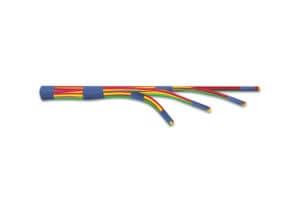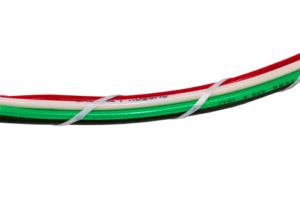Advantages & Disadvantages of Electrical Bindings for Electrical Contractors

There are various industry terms for organizing wire: structured wiring, structured cable systems, wire and cable management systems etc… They all have the same basic meaning though. The goal is to organize the wire and cable in your office, factory, building, machinery, equipment, data center, security system in a neat and organized way to avoid the tangled mess of cords running loosely so that the wires themselves can be easily traced back. In other words, it is about creating a plan to keep the wires together in a safe, organized and functional format that keeps them tidy and easy to manage. Bundling wires and cables does just that.
When electricians bundle cables and wire conductors together, they have several options, which are contingent on the wire and cable type, the electrical code regulations and restrictions, and the manner of installation.
Neat and organized wiring is one of the ways you can tell that an electrician or IT installer takes pride in their work, and if an electric panel is wired by a professional electrician, or if those communications cables are run by an IT professional all the cable and wires are held neatly together. From breakers in an electrical panel where on the right or left side of the panel they exit the box on the same side.
This requires planning and careful execution, and the completed work sometimes resembles a wiring diagram, with each wire turning at a just the right angles next to the connection before it heads up or down and out to the next connection point. In cases like this one might automatically think zip ties or velcro strips would be the solution for these generally short runs, but often it is not.
The most common choices to bundle wire and cable are:
- zip ties
- velcro straps
- electrical tape
- nylon harnesses
So what’s the best type of binding for cable bundles?
It depends.
One-Pull’s wire bundles are all bound with a waxed nylon string into a harness. While there are specific advantages for using waxed nylon binder thread for long runs, there are advantages and disadvantages to each of these cable management solutions.
If the cables are being run over a distance through cable tray, along a floorboard, or over head by j hooks, zip ties may be the right solution if applied correctly. Even Velcro strips may work in this situation if applied close enough together. However, for an electrical panel or in a conduit, zip ties or Velcro strips can be dangerous.
The nylon harness is a good way to keep wire and cable bundled together neatly, efficiently, and effectively. Since the surface area of the binder is minimal it is less likely to snag than a material that wraps around the whole circumference of the bundles. The binder is less likely to damage the wire or cables. Itf applied correctly, the nylon binder can be used with high voltage or low voltage wire and cable, prevents the cables from separating or sagging, and allows just enough space for the wire to dissipate some of the heat generated. It is for all the reasons that the nylon harness is the superior method of bundling, but it too has its drawbacks.
If you are organizing a desk or single workstation, it does not make sense. If you are organizing a short run of cable, say 5 ft, it does not make sense. If you need to continuously add or subtract wires and cables from the configuration, it does not make sense. However, if you are installing over a large distance, and you want to keep the cables together, and the installation is going to be permanent or semi-permanent that the nylon harness is the best choice. For a quick recap, see the list of the pros and cons below:
1) Zip Ties

Advantages
- Good for short and long runs of communication and data wire
- Good for binding together a number of wires connecting computer computers to the wall [image]
- Good for organizing wires so that people don’t trip over them
- A quick solutions for creating a tidier workplace
- They are inexpensive to purchase. You can buy a pack of 100 on Amazon for $5.99.
Disadvantages
- If pulled too tightly, it can damage the wire
- It’s cumbersome to remove if you need to make changes to the number of conductors, or even the location to the device where the cable need to run.
- For large bundles and runs, an electrician can spend a lot of time repeating applying multiple zip ties.
- The zip ties, depending on application and cable and wire type may not be even allowed to bundle cables running into a conduit.
- If allowed in conduit, since the zip ties have a thick tail, it can get caught or snag when pulling the bundle through conduit or even tray
- Tighter bundles can increase the build-up of heat between the conductors. Because of such, some electrical code will not allow this type of bundling to take effect as it presents a potential fire hazard if the cables overheat too much. And zip ties should never be used with higher voltage wire without appropriate derating of the wire and we would still recommend against using them with high voltage wire even if technically allowable.
- Only applicable for low voltage cable by code in conduit, high voltage cables do not allow any foreign objects in the conduit or tray
Overall
Zip ties are ideal for small and long runs of low voltage cable such as data or communication cable, as well as home use and small budgets since they are cheap to purchase. However, they have inefficiencies and even cause dangerous conditions, when it comes to large jobs using high voltage wire. This is especially true for pulling long high voltage wire runs through tray and conduit installations. If the zip ties get stuck in a conduit, you’ll end up paying more in terms of labor costs than had you used a more expensive material, but one that would have still saved time on getting the job done. In addition, applying zip ties to the wrong situation can open you up to a whole lot of avoidable liability.
2) Velcro

Advantages
- Easy to apply
- Since it is soft it is unlikely to damage the wire
- The velcro pull tabs makes them easy to tighten, remove, and reuse
- Good for data cabling applications
- It is an alternative to an “H stitch”
- Useful for adding additional runs since the velcro can be quickly detached
Disadvantages
- The zip ties can fray over time—there are only so many uses before the velcro begins to tear
- Like the zip ties (although not as prominent), the velcro bindings thickness can result in a cable bundle getting caught on something when being pulling through a long conduit or tray
- Worse if the strips comes off, or slides down and bunch the contractor’s cable could become stuck in the conduit requiring much more effort, time and money to get the job done.
- It’s not applicable on any wires that tend to get hot (such as power wires)
- Only applicable for low voltage cable by code, high voltage cables do not allow any foreign objects in the conduit or tray and like Zip ties Velcro wraps qualify as a foreign object.
Overall
Velcro has good applications Data centers and IT solutions but has limited applications for industrial and commercial construction, particularly since it is thick (increased chance of it snagging) and it is not suitable for high voltage wire.
3) Electrical Tape

Advantages
- Holds the wires together while still being loose enough for the wires to “breathe” or allow the heat to disperse and not build.
- Can be quickly released as feeding through conduit with high voltage wires, which eases the pull as the individual wires are more flexible in curves, angles, and bends
- Less expensive than velcro straps; you can purchase a multi-color 5 pack for 8.99
- Leaves minimal sticky residue
- However, due to the low stickiness of Electrical Tape it also can be pushed
Disadvantages
- Electrical tape/Pull tabs are not very durable and can be easily snapped
- Since the width of the tape must wrap around the bundle completely, it creates a larger surface area that is more susceptible to snagging.
- Bundles made with electrical tape are very loose in between the area where the tape is applied on the cables. This will lead to sagging and less aesthetically looking cables, especially if run over head on “J” hooks
- Electrical tape again may not be approved in the electrical conduit itself, and is considered a foreign object by most electrical code books. Electrical tape has its valid function in the code, but just as a method to hold the wires together in high voltage conduit is not one of them.
Overall
Electricians love the ease and cost of using electrical tape. In fact we use them as pull tabs on our nylon harness wire bundles. It is a popular, cost-effective way to bind wires together. But for long runs, it can consume a lot of the electrician’s time, even though the material is comparatively inexpensive, the electrician ends up wasting time which translates into less time to do other work, which, ultimately, means less money.
For long runs or lots of repetitive short run, multi-conductor cable bundles, they nylon harness bundle is king.
4) Nylon Harnesses

Advantages
- Has excellent heat resistance [and can even be plenum rated] which makes it good for high voltage, or use in “public” spaces or transportation applications.
- Holds the bundled together tightly while also providing enough room to breathe.
- The binding is tight enough to limit sag, which is good when an electrician is pulling handing bundles on a ceiling grid
- Less likely to catch than something that goes all the way around the nylon
- Saves time for repetitive, long bundles
- A well applied nylon harness is less likely to snag on conduit or tray (outside of loose wire) when being pulled than velcro or zip tie
- Good for large, multi-conductor bundles
- Ideal for long runs in commercial construction
- If plenum rated, has excellent fire safety rating
- Is allowed by electrical code as “part of the cable” to be run in any type of conduit or tray. Making it the only application for both high voltage and low voltage wire and cable in conduit or tray. While other options may be used for low voltage, the harness is the only approved for high voltage applications.
Disadvantages
- Since the nylon harness spiral around the entire bundle (which could be 100 feet+ in length), it is designed to be more permanent than velcro
- Adding and subtracting wire can be challenging since once the nylon harness is cut it will need to be replaced.
- Cutting larger cables to smaller lengths requires remembering to tape off both sides of the cut everytime or the binder will come undone.
- May require more pulling tension and lube to pull through certain aspects of conduit, bends, corners and angles in particular as the cable is more rigid.
Overall
We’re obviously a little bias since we specialize in manufacturing bundled cable encased in a nylon harness. Nonetheless all of these bindings have pros and cons which an electrician must weigh when they are on the job site.

READY TO SAVE TIME & MONEY WITH BUNDLED CABLE?
Get a quote on our custom cable bundles today.


